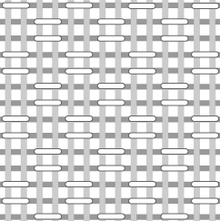Plain weave
Plain weave (also called tabby weave, linen weave or taffeta weave) is the most basic of three fundamental types of textile weaves (along with satin weave and twill).[1] It is strong and hard-wearing, and is used for fashion and furnishing fabrics.



In plain weave cloth, the warp and weft threads cross at right angles, aligned so they form a simple criss-cross pattern. Each weft thread crosses the warp threads by going over one, then under the next, and so on. The next weft thread goes under the warp threads that its neighbor went over, and vice versa.[2]
- Balanced plain weaves are fabrics in which the warp and weft are made of threads of the same weight (size) and the same number of ends per inch as picks per inch.[3]
- Basketweave is a variation of plain weave in which two or more threads are bundled and then woven as one in the warp or weft, or both.
A balanced plain weave can be identified by its checkerboard-like appearance. It is also known as one-up-one-down weave or over and under pattern.[1]
Examples of fabric with plain weave are chiffon, organza, percale and taffeta.
Designation
According to the 12th-century geographer al-Idrīsī, the city of Almería in Andalusia manufactured imitations of Iraqi and Persian silks called ‘attābī, which David Jacoby identifies[4] as "a taffeta fabric made of silk and cotton (natural fibers) originally produced in Attabiya, a district of Baghdad."
End uses
Its uses range from heavy and coarse canvas and blankets made of thick yarns to the lightest and finest cambries and muslins made in extremely fine yarns.
References
Citations
- Kadolph (2007), p. 225–229.
- Emery, Irene (1966). The Primary Structures of Fabrics. The George Washington University and Textile Museum Library, Washington, D.C.: The Textile Museum. p. 76.
- Kadolph (2007), p. 229.
- Jacoby, "Silk Economics and Cross-Cultural Artistic Interaction: Byzantium, the Muslim World, and the Christian West" Dumbarton Oaks Papers 58 (2004:197-240) p. 217, crediting al-Idrīsī.
Bibliography
- Kadolph, Sara J., ed. (2007). Textiles (10th ed.). Saddle River, New Jersey: Prentice-Hall. ISBN 0-13-118769-4.
External links

